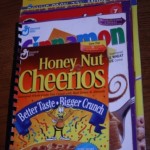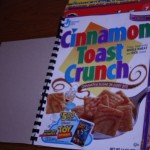In one of my earlier posts “Read the Playroom“, I briefly mentioned the suggestion of posting “environmental print” in the playroom. Environmental print is simply “print that we see in our everyday environment” such as signs, banners, billboards, logos, etc.
Today, I have a simple activity, but it may take a bit of time to collect.
You are going to cut out the front of cereal boxes, snack boxes, and restaurant boxes/bags such as donut box tops or burger king bags. And you are going to combine them all to make a book for your child’s reading corner. If you dont have a reading corner, book display, bookshelf, or something like it. PLEASE consider establishing a designated area for reading. Make it cozy with bean bags, pillows, a little lamp, etc. You want this area to be one that your little one frequents.
I am posting the picture of my assembled book, but I was a teacher who “bound” the book at school. You can 3-whole punch it and use binder rings, stick it in a 3-ring folder or binder, put them in sheet protectors, or anything you can think of that align with the resources available to you.
Please e-mail me pictures of your completed work so I can post ideas for other moms and dads on the visitor share page 🙂
Remember, as mentioned in an earlier reading post, this doesn’t mean your child can read necessarily, but it is a great way to attach meaning to print, to reinforce that reading can be linked with picture clues, and to provide the repetition to introduce new reading skills such as phonemic awareness which I will address in detail later.
And remember that each time you cut out a new print to save it is an opportunity to teach about it….to talk about what it says, the letters in the word(s), the way that you can identify it, etc. Have fun!





